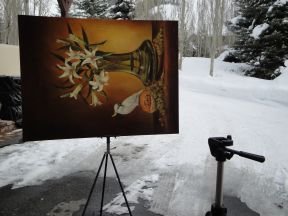Now you have a better understanding of the camera, equipment and lighting from Part 1 – so what’s next?
It is time to experiment with taking your own photographs. The steps below will help you achieve great results. The quality has been good enough for gallery opening invitations, magazine articles, advertisements, museum catalogs and my website and blog. Now the only time I hire a ‘pro’ is when I need a high resolution reproductions such as giclee, posters or books.
With these easy digital tips, you can learn how to photograph your own artwork the easy way. This is how I do it…
PHOTOGRAPHING THE ART!
-
Make sure your batteries are fully charged and don’t forget the ‘memory card’!!!
-
Set up art on easel.
-
Secure camera on tripod.
-
Use only one light source to illuminate the art.
-
Wear dark clothing to cut down on possible color or glare reflection.
-
Adjust the White Balance (easy to do, check your manual) for the proper light source.
-
Set the camera to “P” mode ( or manual if you know what you are doing!)
-
Carefully align the art in the camera.
-
Make sure the sides are straight and tops and bottoms are level in your viewfinder or LCD.
-
If you cannot square all the lines, if the entire piece of art is in sharp focus – the image can be squared in image software.
-
-
Make sure the camera is steady or use self timer.
-
Immediately check the image in the LCD. Check and double-check apparent sharpness.
-
Enlarge is several times to see if it is in focus.
-
Check for glare
-
-
Take at least 3 shots of every piece of art
-
I often try different light angles for different results.
-
Experiment!
-
-
The ‘pros’ say that most art looks better with slight underexposure.
-
Try and upload the images to your computer so you can reshoot if needed!
-
Use Photoshop or other image software to crop and correct colors.
Be patient with yourself and the learning curve. Strangely, I have not found the perfect lighting formula for shooting my own paintings. Sometimes my art photographs better in the shade and othertimes the color is better when angled toward the sun. However, if I take the time to try different lighting choices, I am usually assured a good shot. You can see the photographs I have taken of my art on my art website, http://www.lorimcnee.com!
For further reading: http://arthistory.about.com/od/collecting_and_appraising/l/bl_photoartqt.htm













Great post! I love creative entries that support the arts. I am a children’s book author by trade but I truly enjoy photography and all types of art-oriented fields. Keep up the great work.
Tara Michener
http://www.taramichener.com
Hi Tara – thanks for visiting this blog and taking time to comment. I appreciate it. Hope you come back again…Lori 🙂
Excellent follow-up to your previous article Lori. I would add that it’s a good idea to allow plenty of time before any event or publication requiring the photos, as sometimes the weather and quality of light can seriously affect the chances of getting good shots!
Good to see you here again, River and thanks for adding your thoughts.
Yes, it is important to give yourself plenty of time to get a good shot before a show. I have to admit, I am a crammer! In fact, this past show was hard for me to photograph because I waited until the last minute and then it snowed on the day I needed to photograph! That was a challenge. I literally was trying to take shots between snow flurries…that was stressful – but I did manage to get a few good images.
River, please feel free to submit any art tip or art related article to share with FineArtTips.com. I will link to you!
Best-
Lori 🙂
Great information. I always was under the impression it was complicated to photograph artwork. Thank you for passing on all your expertise!
Hi Celia,
Thanks for the nice words. I am no expert at photography, but these tips really do work well for me. There are much better ways to photograph artwork, but this easy way of doing it will get artists started!
I appreciate your feedback-
Lori 🙂